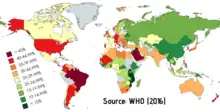Physical activity

Physical activity is defined as any voluntary bodily movement produced by skeletal muscles that requires energy expenditure.[1] Physical activity encompasses all activities, at any intensity, performed during any time of day or night.[2] It includes both exercise and incidental activity integrated into daily routine. This integrated activity may not be planned, structured, repetitive or purposeful for the improvement of fitness, and may include activities such as walking to the local shop, cleaning, working, active transport etc. Lack of physical activity is associated with a range of negative health outcomes, whereas increased physical activity can improve physical and mental health, as well as cognitive and cardiovascular health.[3] There are at least eight investments that work to increase population-level physical activity, including whole-of-school programmes, active transport, active urban design, healthcare, public education and mass media, sport for all, workplaces and community-wide programmes.[4][5] Physical activity increases energy expenditure and is a key regulator in controlling body weight (see Summermatter cycle for more).[6]
Terminology misconception
"Exercise" and "physical activity" are frequently used interchangeably and generally refer to physical activity performed during leisure time with the primary purpose of improving or maintaining physical fitness, physical performance, or health. However, physical activity is not exactly the same concept as exercise. Exercise is defined as a subcategory of physical activity that is planned, structured, repetitive, and purposeful in the sense that the improvement or maintenance of one or more components of physical fitness is the objective.[1] Conversely, physical activity includes exercise but may also be unplanned, unstructured, random and non-purposeful carried out for a multitude of reasons.

A 2021 study shows that people who start successful physical activity programmes maintain much of it for at least 3 months.[7]
Intensity
Physical activity can be at any intensity, from a simple twitch of a muscle to an all-out sprint. In practice, physical activity can be viewed as a continuum from sedentary behavior to vigorous intensity activity. Intensities are broadly categorized according to energy expenditure using a standard measure of intensity, metabolic equivalents (METs). The broad categories are sedentary behavior, light activity, moderate activity and vigorous activity.
Example activities at each intensity
The following table documents some examples of physical activities at each intensity level. Depending on the individual and the activity involved, activities may overlap intensity categories or change categories completely.
| Intensity | Example Activities |
|---|---|
| Sedentary Behavior | Sitting, lying |
| Standing | Standing still |
| Light Physical Activity (LPA) | Slow walking, shuffling around the house |
| Moderate Physical Activity (MPA) | Brisk walking, jogging, light swimming, stair climbing |
| Vigorous Physical Activity (VPA) | Fast running, fast cycling, sprinting |
Physical activity as prevention and therapy
Many studies have demonstrated the potential beneficial effects of physical activity on the prevention and therapy of many disorders as Obesity[8][9] and Irritable bowel syndrome [10][11] Physical activity has been shown to reduce anxiety as a condition (individual physical exercise, without continuity), anxiety as a personality trait (continuous performance, "exercise" of certain physical activities), psycho-physiological signs of anxiety - blood pressure and heart rate (moderate physical activity can lead to a decrease in the intensity of short-term physiological reactivity and encourage recovery from short-term physiological stressors (Biddle et al., 2000)). For people with a severe depressive episode and anxiety disorder, long and short walks proved to be the most effective; for people with substance abuse disorders, bipolar disorder and frequent psychotic decompensation, "strenuous" gymnastics and riding proved to be the most effective.
Physical activities during leisure and clusters of different forms of meaningfulness

Different forms of physical activity in leisure time can be divided into different clusters of activities that have a common denominator in the form of type of meaningfulness, se model to the right (Lundvall & Schantz 2013).[12]
These separate forms of meaningfulness consist of (i) competition and championship, (ii) nature encounters, (iii) aesthetic-expressive, (iv) fitness gymnastics and play, (v) everyday exercise and (vi) five different basic forms of physical training (aerobic, anaerobic, strength, flexibility and coordination training).
How these different clusters have been treated over time from 1813 to today in a context of teacher training for physical education in the Swedish school system has been described by the Swedish professors in human movement science Suzanne Lundvall & Peter Schantz (2013).[13]
Recommendations for physical activity (including sleep and sedentary behavior)
Global recommendations
The World Health Organization recommend the following:[1]
Adults aged 18–64


1. Adults aged 18–64 should do at least 150 minutes of moderate-intensity aerobic physical activity throughout the week or do at least 75 minutes of vigorous-intensity aerobic physical activity throughout the week or an equivalent combination of moderate- and vigorous-intensity activity.
2. Aerobic activity should be performed in bouts of at least 10 minutes duration.
3. For additional health benefits, adults should increase their moderate-intensity aerobic physical activity to 300 minutes per week, or engage in 150 minutes of vigorous-intensity aerobic physical activity per week, or an equivalent combination of moderate- and vigorous-intensity activity.
4. Muscle-strengthening activities should be done involving major muscle groups on 2 or more days a week.
Adults aged 65+
1. Adults aged 65 years and above should do at least 150 minutes of moderate-intensity aerobic physical activity throughout the week or do at least 75 minutes of vigorous-intensity aerobic physical activity throughout the week or an equivalent combination of moderate- and vigorous-intensity activity.
2. Aerobic activity should be performed in bouts of at least 10 minutes duration.
3. For additional health benefits, adults aged 65 years and above should increase their moderate-intensity aerobic physical activity to 300 minutes per week, or engage in 150 minutes of vigorous-intensity aerobic physical activity per week, or an equivalent combination of moderate-and vigorous-intensity activity.
4. Adults of this age group, with poor mobility, should perform physical activity to enhance balance and prevent falls on 3 or more days per week.
5. Muscle-strengthening activities should be done involving major muscle groups, on 2 or more days a week.
6. When adults of this age group cannot do the recommended amounts of physical activity due to health conditions, they should be as physically active as their abilities and conditions allow.
Children and Adolescents aged 5–17
1. Children and youth aged 5–17 should accumulate at least 60 minutes of moderate- to vigorous-intensity physical activity daily.
2. Amounts of physical activity greater than 60 minutes provide additional health benefits.
Country-level recommendations
Australia,[14] New Zealand,[15] the United Kingdom,[16] Canada[17] and the United States[18] are among the countries that have issued physical activity recommendations.
Predictors of physical activity levels
The amount of physical activity conducted by a population—and by extension the proportion of that population reaching guidelines or other specified thresholds—is dictated by a number of factors including demographics (e.g., age, sex, ethnicity), population health status, cultural aspects, and the state of the environment itself (e.g. infrastructure that affords physical activity). Demographic groups can also intersect, increasing risk to individuals who are both female and socially disadvantaged for example.[19]
Studies have shown that as availability of natural environments (e.g., parks, woodlands, inland waters, coasts) increases, more leisure-time physical activity such as walking and cycling are reported.[20] Meteorological conditions have been found to predict physical activity differently in different types of environment. For example, in a large population-based study in England, higher air temperatures and lower wind speeds were associated with increased physical activity.[21]
Globally, in 2016, according to a pooled analysis of 298 population-based surveys, around 81% of students aged 11–17 years were insufficiently physically active.[22] The region with the highest prevalence of insufficient activity in 2016 was high-income Asia Pacific.[22]
As a health indicator

Physical activity, qualified in the form of a physical activity vital sign (PAVS) metric, has been proposed as a screening tool in primary care diagnostics.[23] It has been suggested to correspond with BMI[24] and chronic disease, when coupled with demographic information[23] as well as a tool for identifying patients who do not meet certain physical activity guidelines.[25] Generally, this metric is evaluated by a self-reported medical questionnaire, which can significantly affect the validity and applicability of a PAVS in clinical treatment determination.[23][25]
See also
- Physical inactivity
References
- 1 2 3 Global Recommendations on Physical Activity for Health, 2009. World Health Organization. Geneva, Switzerland. Accessed 13/07/2018. Available at: http://www.who.int/ncds/prevention/physical-activity/en/
- ↑ Pedišić, Ž. (2014). Measurement issues and poor adjustments for physical activity and sleep undermine sedentary behaviour research—the focus should shiftep, sedentary behaviour, standing and activity. Kinesiology, 46 (1), 135-146. Retrieved from https://hrcak.srce.hr/123743
- ↑ Ione Avila-Palencia (2018). "The effects of transport mode use on self-perceived health, mental health, and social contact measures: A cross-sectional and longitudinal study". Environment International. 120: 199–206. doi:10.1016/j.envint.2018.08.002. hdl:10044/1/62973. PMID 30098553. S2CID 51965322.
- ↑ Fenech, Amanda; Chockalingam, N.; Formosa, C.; Gatt, A. (1 January 2021). "Longitudinal effects of evidence-based physical education in Maltese children". Child and Adolescent Obesity. 4 (1): 98–116. doi:10.1080/2574254X.2021.1915041. S2CID 237846270.
- ↑ Milton, Karen; Cavill, Nick; Chalkley, Anna; Foster, Charlie; Gomersall, Sjaan; Hagstromer, Maria; Kelly, Paul; Kolbe-Alexander, Tracy; Mair, Jacqueline; McLaughlin, Matthew; Nobles, James (2021-05-12). "Eight Investments That Work for Physical Activity". Journal of Physical Activity and Health. -1 (aop): 625–630. doi:10.1123/jpah.2021-0112. ISSN 1543-5474. PMID 33984836.
- ↑ S, Summermatter; C, Handschin (November 2012). "PGC-1α and Exercise in the Control of Body Weight". International Journal of Obesity. 36 (11): 1428–35. doi:10.1038/ijo.2012.12. PMID 22290535. S2CID 26821676.
- ↑ Madigan, Claire (June 2021). "Effectiveness of interventions to maintain physical activity behavior (device-measured): Systematic review and meta-analysis of randomized controlled trials". Obesity Reviews. 22 (10): e13304. doi:10.1111/obr.13304. PMID 34129276. S2CID 235437649.
- ↑ Chin SH, Kahathuduwa CN, Binks M. Physical activity and obesity: what we know and what we need to know. Obes Rev. 2016 Dec;17(12):1226-1244. doi: 10.1111/obr.12460.
- ↑ Wareham NJ, van Sluijs EM, Ekelund U. Physical activity and obesity prevention: a review of the current evidence. Proc Nutr Soc. 2005 May;64(2):229-47. doi: 10.1079/pns200542
- ↑ Johannesson E, Simrén M, Strid H, Bajor A, Sadik R. Physical activity improves symptoms in irritable bowel syndrome: a randomized controlled trial. Am J Gastroenterol. 2011 May;106(5):915-22. doi: 10.1038/ajg.2010.480. Epub 2011 Jan 4. PMID 21206488.
- ↑ Costantino A, Pessarelli T, Vecchiato M, Vecchi M, Basilisco G, Ermolao A. A practical guide to the proper prescription of physical activity in patients with irritable bowel syndrome. Dig Liver Dis. 2022 Nov;54(11):1600-1604. doi: 10.1016/j.dld.2022.08.034. Epub 2022 Sep 21. PMID 36153192.
- ↑ [(7) https://www.researchgate.net/publication/273319321_Physical_Activities_and_Their_Relation_to_Physical_Education_A_200-Year_Perspective_and_Future_Challenges Title/Lundvall, S. & Schantz, P. 2013. Physical Activities and Their Relation to Physical Education: A 200-Year Perspective and Future Challenges. The Global Journal of Health and Physical Education Pedagogy 2(1):1-16]
- ↑ [(7) https://www.researchgate.net/publication/273319321_Physical_Activities_and_Their_Relation_to_Physical_Education_A_200-Year_Perspective_and_Future_Challenges Title/Lundvall, S. & Schantz, P. 2013. Physical Activities and Their Relation to Physical Education: A 200-Year Perspective and Future Challenges. The Global Journal of Health and Physical Education Pedagogy 2(1):1-16]
- ↑ "Australia's Physical Activity and Sedentary Behaviour Guidelines". The Department of Health Australia. Retrieved 2018-07-13.
- ↑ "Physical Activity". Ministry of Health. Retrieved 2018-07-13.
- ↑ "UK physical activity guidelines". Gov.uk. Retrieved 2018-07-13.
- ↑ "CSEP | SCPE". csepguidelines.ca. Retrieved 2021-09-19.
- ↑ "Physical Activity Guidelines for Americans 2nd Edition". Office of Disease Prevention and Health Promotion. Retrieved 2020-12-04.
- ↑ Hopkins, Ellyse (2023-11-10). The ‘double jeopardy’ of practice: Changing relationships between physical activity and young women from disadvantaged areas (thesis thesis). Cardiff Metropolitan University. doi:10.25401/cardiffmet.24534943.v1.
- ↑ Elliott, Lewis; White, Mathew; Taylor, Adrian; Herbert, Stephen (2015). "Energy expenditure on recreational visits to different natural environments". Social Science and Medicine. 139: 53–60. doi:10.1016/j.socscimed.2015.06.038. hdl:10871/19949. PMID 26151390.
- ↑ Elliott, Lewis; White, Mathew; Sarran, Christopher; Grellier, James; Garrett, Jo; Scoccimarro, Enrico; Smalley, Alexander; Fleming, Lora (2019). "The effects of meteorological conditions and daylight on nature-based recreational physical activity in England" (PDF). Urban Forestry & Urban Greening. 42: 39–50. doi:10.1016/j.ufug.2019.05.005.
- 1 2 Guthold, Regina; Stevens, Gretchen A.; Riley, Leanne M.; Bull, Fiona C. (2019-11-21). "Global trends in insufficient physical activity among adolescents: a pooled analysis of 298 population-based surveys with 1·6 million participants". The Lancet Child & Adolescent Health. 4 (1): 23–35. doi:10.1016/S2352-4642(19)30323-2. ISSN 2352-4642. PMC 6919336. PMID 31761562.
- 1 2 3 Lin, C.Y.; Gentile, N.L.; Bale, L.; Rice, M.; Lee, S.; Ray, L.S.; Ciol, M.A. (2022). "Implementation of a Physical Activity Vital Sign in Primary Care: Associations Between Physical Activity, Demographic Characteristics, and Chronic Disease Burden". Preventing Chronic Disease. 19 (E33): E33. doi:10.5888/pcd19.210457. PMID 35749145. S2CID 249965817.
- ↑ Greenwood, J.L.J.; Joy, E.A.; Stanford, J.B. (2010). "The Physical Activity Vital Sign: A Primary Care Tool to Guide Counseling for Obesity". Journal of Physical Activity and Health. 7 (5): 571–576. doi:10.1123/jpah.7.5.571. PMID 20864751.
- 1 2 Ball, T.J.; Joy, E.A.; Gren, L.H.; Shaw, J.M. (2016). "Concurrent Validity of a Self-Reported Physical Activity "Vital Sign" Questionnaire With Adult Primary Care Patients". Preventing Chronic Disease. 13: E16. doi:10.5888/pcd13.150228. PMC 4747440. PMID 26851335.